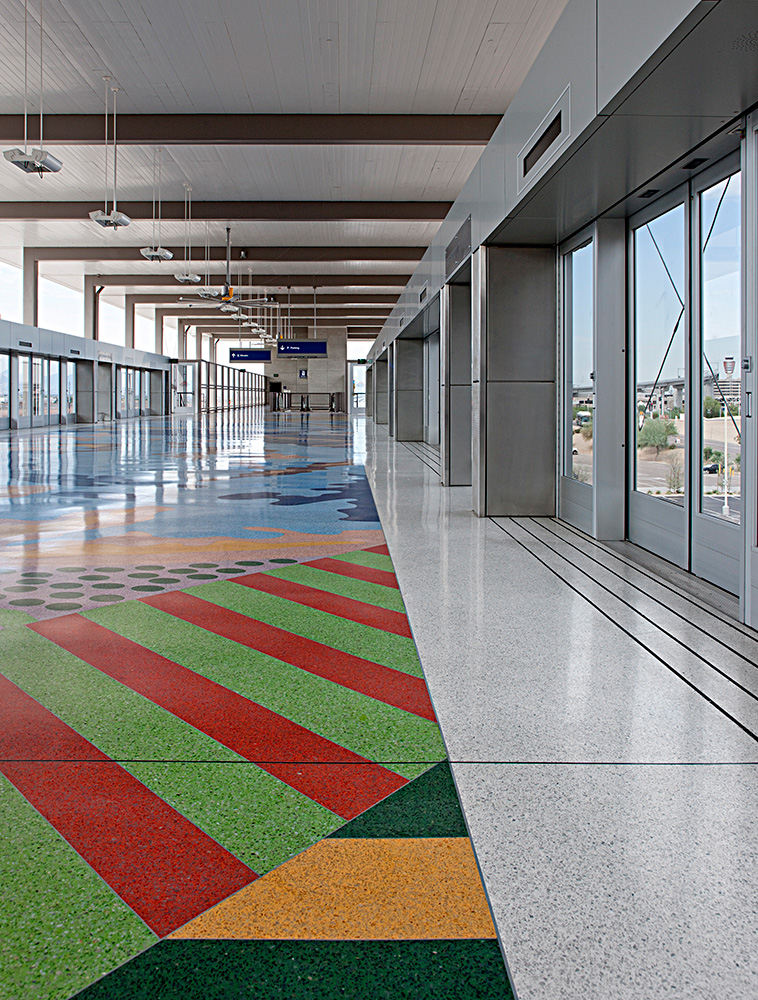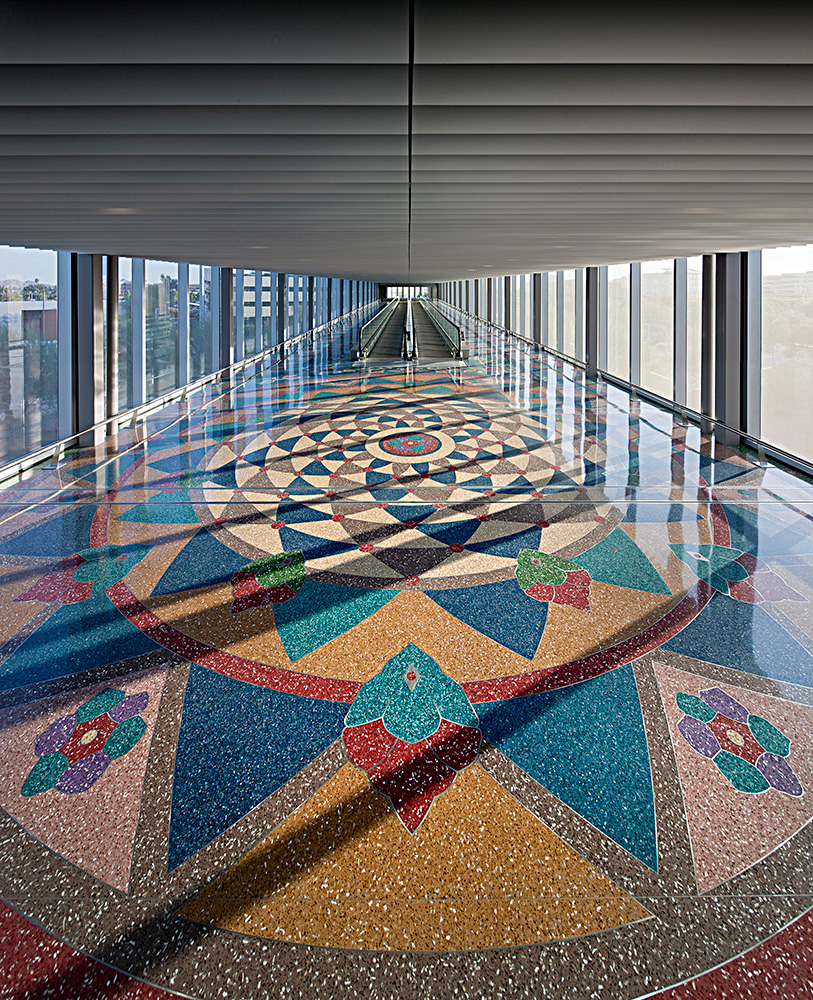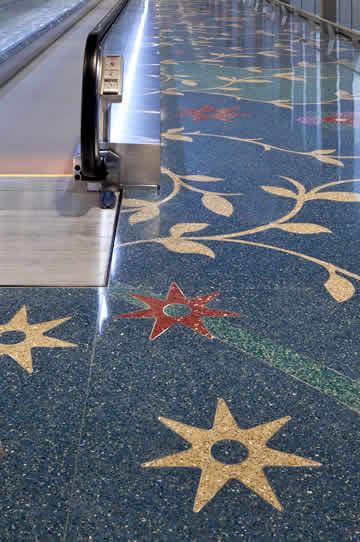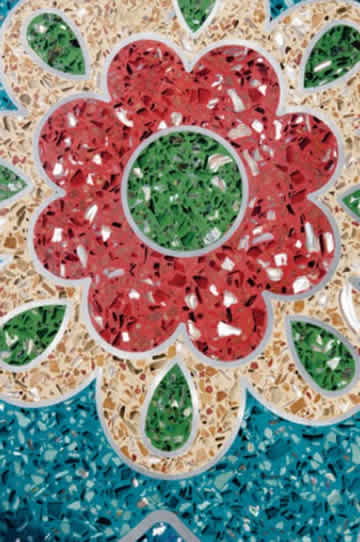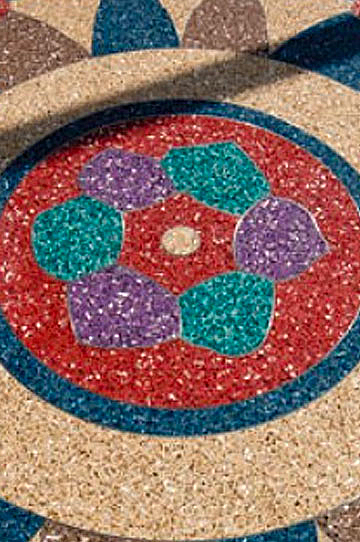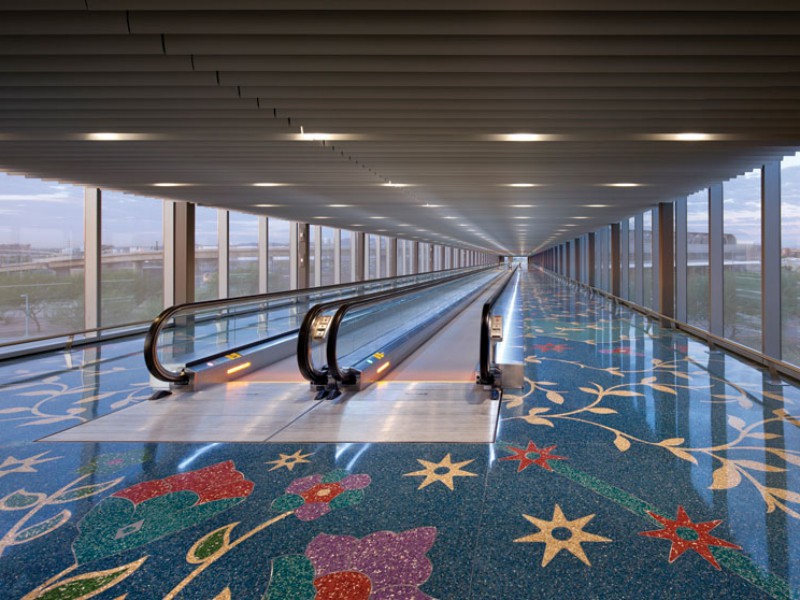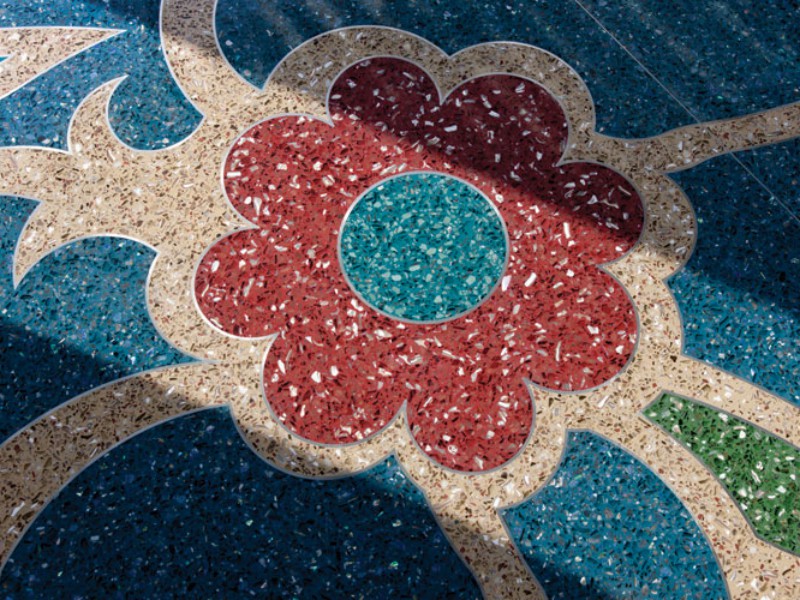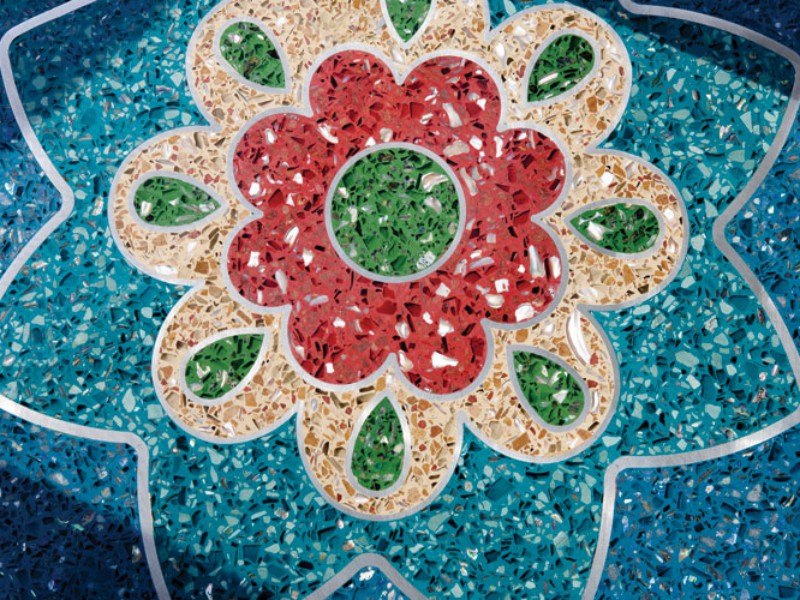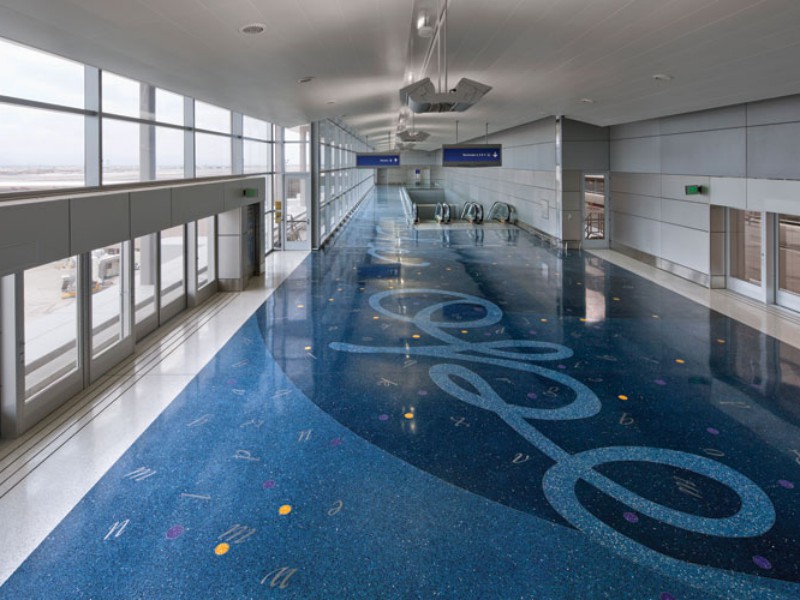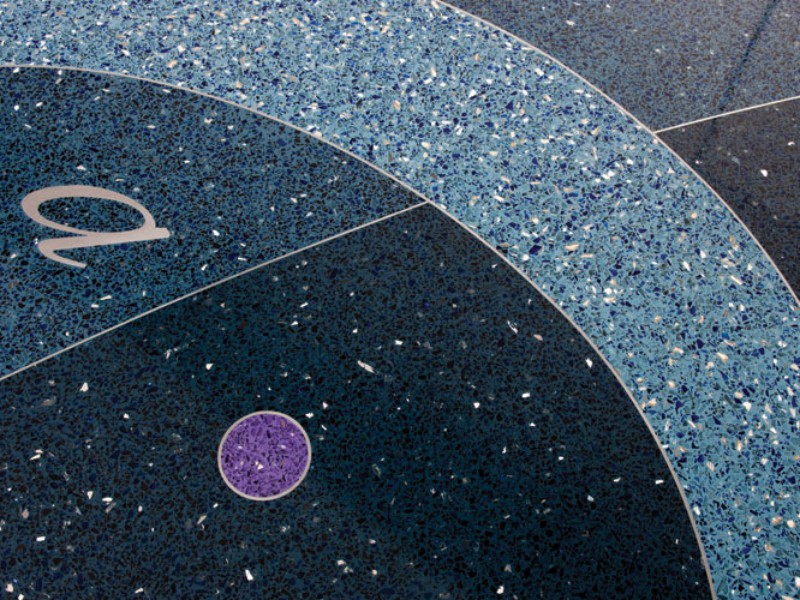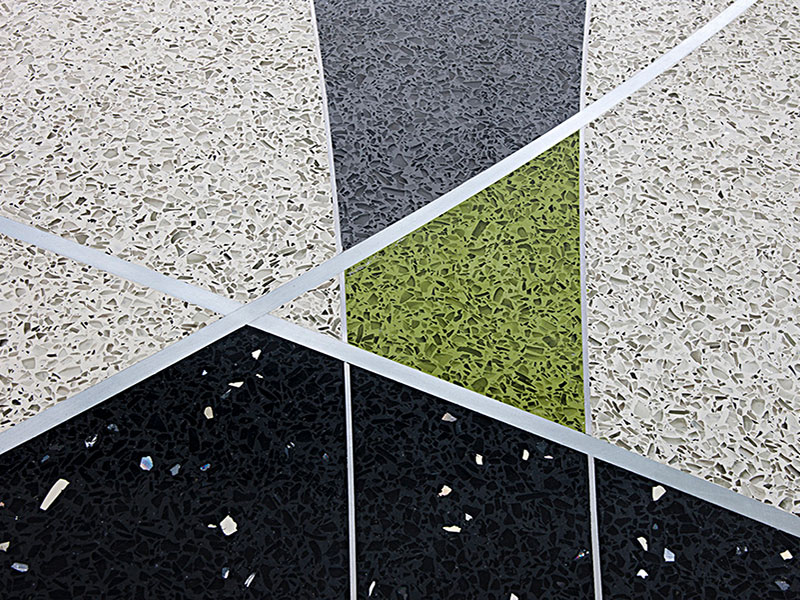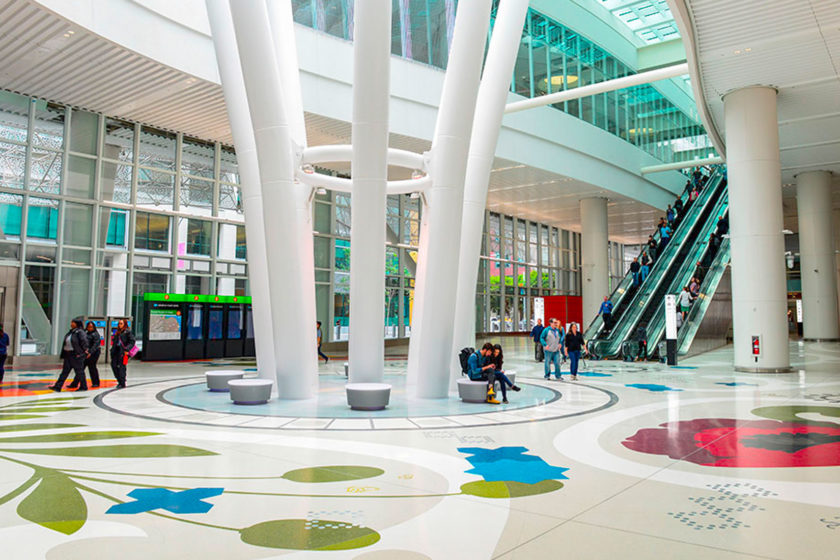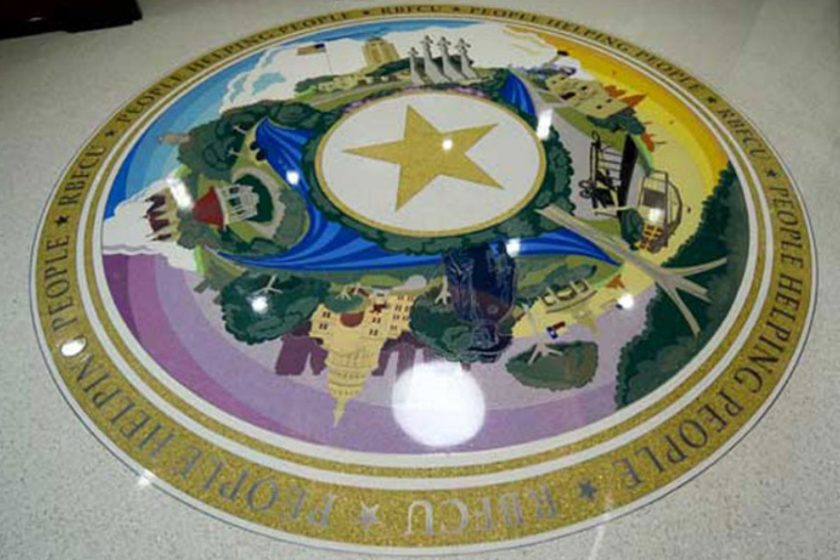Terrazzo Job of the Year at Phoenix Airport Documented in Museum Exhibit
Approximately 2.1 million pairs of feet walked over football-field-size commissioned public art last year in the stations and pedestrian bridges of Phoenix Sky Harbor International Airport’s automated train system. These underfoot art installations are four terrazzo floors, remarkably large and remarkably accessible to a remarkably large public.
The floors were commissioned by the Phoenix Office of Arts and Culture Public Art Program in partnership with Phoenix Aviation Department. Artists worked directly with the architectural design team to incorporate their original artwork into construction plans, and from there to integrate them into the building’s structure as permanent art installations.
Set to be walked over by multiple millions of travelers for many years to come, the floors are now part of the airport’s culturally and stylistically diverse collection of contemporary art.
The SkyTrain terrazzo floors, awarded the 2013 Job of the Year by the National Terrazzo & Mosaic Association (NTMA), are now the subject of a museum exhibit at Phoenix city hall.
Museum Quality
After witnessing the five-year-long creative process from start to finish that set in stone the artists’ original designs, it was clear to members of Phoenix Arts & Culture Commission that the story was a “rare opportunity.” They saw it as a tale well worth telling to the public who would walk on the floors, said Ed Lebow, Public Art Program Director of the City of Phoenix Office of Arts & Culture.
The resulting exhibit, “Art Under Foot: Handmade Floors at the PHX Sky Train” is open to the public at The Gallery @ City Hall through Feb. 27, 2015. The exhibit documents the process from hand-drawn art to digital images and through each stage of the construction process.
“It’s a very different exhibit in the gallery than we’ve done before,” Susan Shaffer Nahmias, Ph.D., co-curator of the exhibit with Lebow and a member of the Arts & Culture Commission. Instead of the usual framed art, this exhibit is “much more storytelling and a very bright and colorful story,” she said.
The exhibit takes visitors behind-the-scenes to the construction site, from the planning and design stages to the method used to transfer the design to the floor, to pouring the aggregates, to the final fine polish. Several different media recount the process, from photos, design drawings, and computerized models, to written and audio narratives of those involved, and an eight-minute documentary video.
A 10-foot-long, hands-on model showing the step-by-step installation of terrazzo lets visitors experience each stage, from rough stone to the gleaming finished product.
“Visitors find it fascinating. It piques their interest to see the floors themselves,” said Nahmias. “It’s exciting to see people respond to the story and to see them connect with something that before was just a floor, something they didn’t notice.”
An official VIP opening of the exhibit was held on Feb 28, 2014, with over 200 in attendance, including city officials, members of the Arts & Culture Commission, gallery supporters, and many of those involved in the project: the artists who designed the floors and the terrazzo fabrication team led by Advance Terrazzo of Phoenix, and their families.
At the opening, a presentation by NTMA executive director Richard Bruns to Tamie Fisher, the City of Phoenix Acting Aviation Director, commemorated the project’s achievement of Job of the Year, the terrazzo industry’s highest honor. The project was selected from among 52 terrazzo projects nationwide based on design, scope, and craftsmanship.
A Penny for Every Dollar
Phoenix boasts one of the nation’s most dynamic municipal percent-for-art programs. Designating one percent of the city’s capital improvement program budget for public art, the program brings artists together with project designers and city planners to integrate the arts in public spaces. The goal is to making make art more accessible and visible to the public, while bringing enduring beauty to the growing city.
“We make sure it’s not Soviet Union in the ‘60s or another street scape with chain link fences,” explained Nahmias, noting that since the program began, the commissionhas become more adept at identifying projects that are both artistic and durable.
Because Phoenix is a young city in a state that is barely 100 years old, unlike in the eastern U.S. with its longer history, such a program is of particular interest and value.
The Sky Train installation is one of some 170 major projects completed since the Phoenix Office of Arts and Culture Public Art Program was established in1986. Several dozen others are now in progress. The Sky Harbor installation is one of that many that have garnered local and national recognition.
Terrazzo As Art
The Sky Train installation is one of a dozen terrazzo projects that Phoenix’s public art program has completed in recent years. Specified for its design flexibility and durability, terrazzo has been installed in a variety of public facilities, from women’s shelters to fire houses.
“l love the personality it gives to a space,” said Nahmias. “I love the ancient roots in a modern expression.”
Terrazzo as a form of public art has a “long and heralded history,” Lebow added. For hundreds of years, floors have been designed as a welcoming element in architectural spaces, and terrazzo construction techniques are rooted in antiquity. The Sky Train floors follow the strong tradition of the last 100 years of artistic terrazzo design work finding expression in American public spaces and government buildings, such as the Phoenix city hall itself, Lebow said, noting also his hope that the exhibit may draw greater notice to the enduring beauty of those older floors.
“A floor is more than just a surface to walk on,” Lebow said. “What an enormous impact really well designed floors can have on a space.”
Exciting also from an arts perspective is the opportunity terrazzo offers to artists who usually work in two dimensions to bring their creativity to public works on a grand scale, Lebow explained. While public art often lends itself to 3-D expressions, terrazzo floors open the field to painters and printmakers for collaboration with architects to create sensational spaces. As at Sky Train, designs that start small in an artist’s studio can find large-scale expression.
Top of Their Game
This project’s four distinct terrazzo floors with their spectacular designs and graphics accounted for $5.6 million of a $1.5 billion airport construction project. The terrazzo project was launched in 2008 and completed April 8, 2013, with the inauguration of Sky Train operations. The award-winning project is not only exceptionally large for artist-designed floors, but is also unique in a number of other ways.
“The project brought in people working at the top of their game,” Lebow said. To simplify and accelerate the process of accurately transferring a art design from a 2 ½ by 3-foot drawing to a floor larger than a football field, the entire design was cut out of corrugated plastic boards. Laid end-to-end on the floor, the boards were a template for laying out the aluminum divider strips and design elements. Each terrazzo floor employed about 25 skilled workers, logging some 40,000 hours of hand troweling terrazzo mixtures into metal forms and grinding and polishing to create the designs.
An outdoor application of terrazzo on the Sky Train station floor called for another technical innovation. The terrazzo contractor determined that the polyacrylate terrazzo application specified would be subject to cracks on an elevated platform with trains running on both sides. Furthermore, sunlight hits the floor for 18 feet, approximately two-thirds of the design. Because ultraviolet rays would cause chalking of the colors, Advance Terrazzo, with its sister company, developed a special poly aspartic urethane terrazzo binder that holds its color against UV rays and resists cracking.
Works of art
The terrazzo floors are designed for vast spaces with strong natural light, “so every step is full of detail and beauty,” Lebow said. Each floor was designed by a different artist, selected through a competitive process.
“Topo Magic” is a whimsical 11-color depiction of topological maps of the Arizona landscape in the outdoor East Economy Lot Sky Train station platform. The 450-foot-long terrazzo design ranges from 12 to 36 feet in width, totaling approximately10,000 square feet. The floor’s designer, Anne Coe, is a 4th generation Arizonan and one of the state’s most recognized painters. Her work has been included in over 100 exhibitions.
“Journey Through Nature,” the 44th Street enclosed pedestrian bridge at the train system’s first stop depicts the themes of nature and metamorphosis.
Aggregates of abalone shell, native desert stone and locally recycled glass bring dimension to its intricate geometric floral patterns in vibrant colors. The 9,828-square-foot floor was designed by Daniel Martin Diaz of Tucson. Diaz has designed several prominent public installations, including a terrazzo floor in Tucson.
Inside the 44th Street Sky train station, the floor design, “Tailplane Patterns,” is a patterned composition based on the shape of the horizontal stabilizer, or tailplane, of an aircraft. A weaving thread of black provides variation within the symmetry, and a light-reflecting blend of recycled glass and mirror aggregates unifies the 10-color design. Los Angeles painter and mixed media collage artist Fausto Fernandez designed the floor, which is 440 feet long and ranges from 17 to 40 feet wide.
Then, in the terminal station, expected to handle about 2,000 passengers per hour during peak travel periods, is “Variable Order.” Nearly 200 yards long, the design integrates over 1,000 randomly placed water-jet-cut aluminum letterforms superimposed with an elegant handwritten script. The design elements are embedded in five repeating fields of blue, transitioning from dark to light, and back to dark, with an aggregate mix of recycled crushed mirror, blue and clear glass, and abalone shell. Daniel Mayer, an art book and print maker at Arizona State University’s Herberger Institute for Design and the Arts, designed the floor as well as glass murals installed in Sky Train bridges.
Up Next
A Navajo weaver is now developing the terrazzo design for the next phase of the Sky Train floors. Beginning with hand drawings and handwoven wool yarn on a loom, her rich colors and textures will also find expression in immense, durable surfaces to be walked by many millions.
“We live in a high tech age and often forget that the spaces that we build and inhabit are still largely built by hand,” Lebow said. From those who sketch the original design to workers on hands and knees building a layer 3/8-inch thick, the skilled artistry and care that produces these floors is indeed a story worth telling.
The terrazzo floor projects together with the museum exhibit exemplify the highly collaborative spirit of public art. Many minds and hands participate in a process that shares an artistic creation with an exponentially larger public.
“Lots of workers in trades are humble folks; they walk away and no one knows their names,” said Lebow. “With the investment of talent and skill in projects as rewarding as these, it’s important for the public to know who is behind it.”

